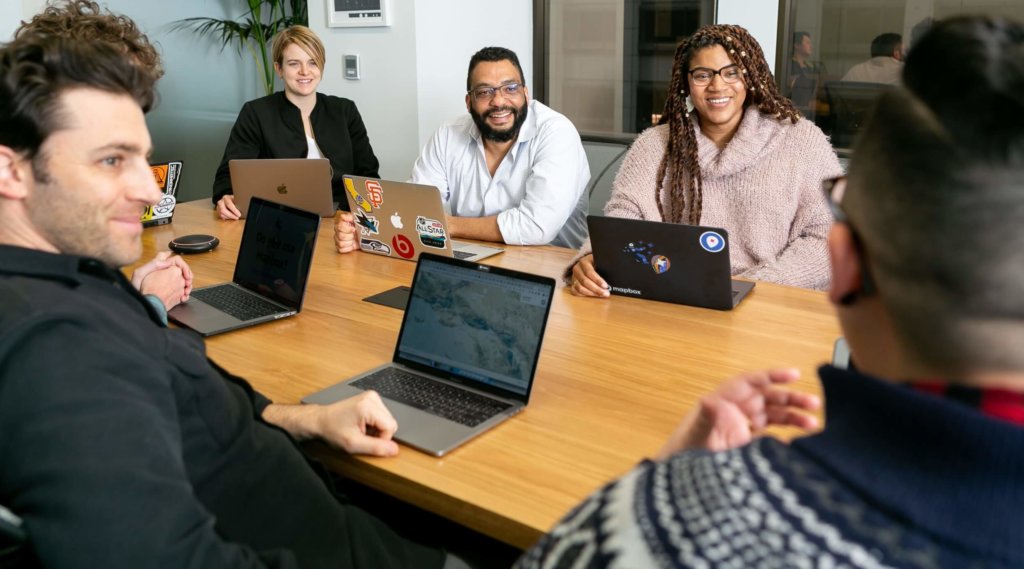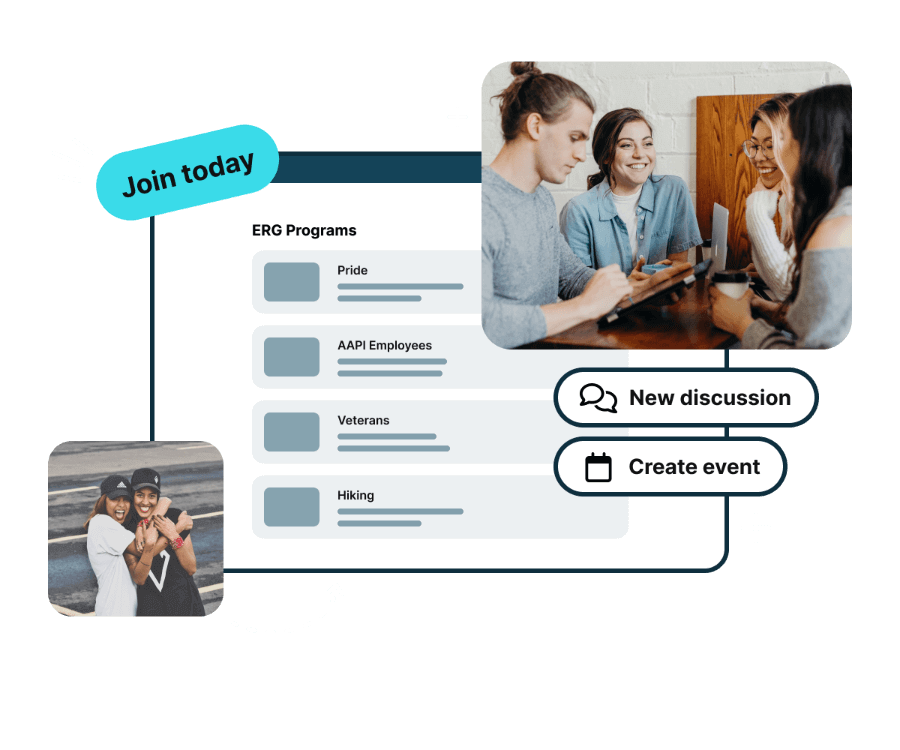As workplaces focus more on diversity, equity and inclusion (DEI), many organizations are realizing the importance of the “I” in that equation—inclusion. Representation is key, but ultimately, employees need to feel valued and included to live up to their full potential and remain at an organization.
Building and supporting Employee Resource Groups (ERGs) is one tried-and-true way that companies can promote a sense of belonging among workers. The Rise Journey’s 2021 State of the Employee Resource Group Report found over 50% of organizations surveyed had three to six ERGs. The rest, a little over 20%, had seven to 15 ERGs. In terms of the most popular ERGs, the top three were:
- LGBTQIA+
- Women
- Black & African American
Employees who feel a high sense of belonging are far more likely to be engaged, loyal and to promote their organizations as good places to work than those who feel lower levels of belonging, according to research by Coqual.

What is an ERG?
An ERG is often a voluntary group that offers an opportunity for people with common identities or interests in the workplace to come together. These groups, which may also have other names, including affinity groups, Business Resource Groups (BRGs) or Business Resource Networks (BRNs), offer forums in which employees can share experiences, information and resources in a supportive environment.
ERGs often focus on underrepresented or historically disadvantaged groups, for example, women, BIPOC, LGBTQIA, veteran or disabled employees. But they’ve also evolved to focus on working parents, mental health, wellness and beyond.
Among Fortune 500 companies—such as Amazon and PNC— 90 percent utilize ERGs as an employee engagement strategy. While ERGs are most often employee-led, formal company support is crucial for them to thrive and contribute to the organization as a whole.
How Do Employee Resource Groups Support Employees?
There are several benefits of employee resource groups. They can help employees feel more engaged and invested in their organization, while also building community at work within the employee-led groups. Below is how ERGs can benefit employees successfully.
Increase engagement
ERGs help employees feel part of an organization, especially if it’s an enterprise company. With so many people and amidst today’s hybrid workplace, employees can feel isolated from each other and the organization. ERGs can boost employee morale, and allow employees to connect while showcasing that connection and rapport are important to the company at large. This type of connection helps to engage and motivate employees to take more care in their work, their relationships and their productivity.
Create a sense of community
ERGs create a sense of community, which can have a positive impact on employees’ feelings of trust and engagement. These employee-led groups offer a psychologically safe space for discussion, solidarity and support, in which people can feel free to self-identify and be their authentic selves.
Build feedback loops
ERGs also provide opportunities for participants to simply be heard, not only by other members of their group but by the larger organization. This allows a company to keep a pulse on how various employee groups are feeling and thriving within the organization.
Empower employees
Inclusive workplace ERGs give employees a platform to unite over wants and needs. This can empower them to work with senior leaders and HR to make changes in the organization as necessary. These groups embolden employees with a community that makes them part of something bigger than themselves. In surveying 400 women, online community platform Fairygodboss found top policy changes achieved by women’s resource groups included:
- 55% of the women we surveyed said their women’s network helped improve parental leave benefits
- 53% said their group advocated for better and more flexible work schedules or vacation policies
- 44% said their women’s ERG helped establish a mentorship or sponsorship program at work
Group members can also learn from one another and take advantage of resources for personal and professional development, whether formal and informal.
What are the Benefits of ERGs for Organizations?
By supporting ERGs, companies foster a diverse, inclusive work environment and cultivate a culture of allyship. Working with these affinity groups can aid companies in the following areas.
DEIB Initiatives
ERGs are vital components of diversity, equity, inclusion and belonging (DEIB) initiatives as companies aim to better serve their entire employee population, especially those untapped employee groups. These groups can help companies create a strong community around shared identities, while also building safe spaces for people to show up as their true selves. Often, ERG performance is a main component of DEI metrics when looking at engagement and belonging for employees.
Employee development
ERGs are also a great way to deliver employee-driven development in groups where social learning and experiential learning can collide to help upskill employees. These groups can lead workshops, seminars, webinars and more to help drive home skills and knowledge useful to employees’ career paths and company objectives. They can also demonstrate immediate ways to apply this learning, ensuring full retention and use in professional development groups.
Recruitment & retention
Prospective employees, especially Gen Zers, are looking to be part of companies with an inclusive environment that better incorporate their full identities into work. Therefore companies with employee resource groups are showcasing to potential applicants they care about the full self of an employee. These can be great places for new hires to get involved early in their careers, helping them feel part of the organization and company culture, which increases their likelihood of staying.
Creativity & innovation
ERGs can also be places where employees discuss and determine new avenues for work productivity, product features and customer segments. Conversation and gathering can lead to new ideas from diverse minds who may not have had the opportunity to get together previously. These ideas can benefit employees and customers by encouraging creative advancement and progression while also allowing for informal leadership opportunities.
Types of Employee Resource Groups
Employee resource groups can be found in a wide variety of companies. The ERG groups can center around demographics, personal experiences, general interests and more. Here are some examples of what ERGs focus on.
- Gender
- Ethnicity
- Nationality
- Sexuality
- Neurodiversity
- Accessibility
- Military Service
- Parental status
- Pets
- Hobbies
Examples of Best Practices for Employee Resource Groups
While employee resource groups are a valuable tool for increasing inclusion, not all are created equal. Companies can increase the effectiveness of these ERG groups by following employee resource group best practices to maximize impact.
Establish Accountability
ERGs should be established with a clear sense of mission and specific goals connected to business impact. Goals can include priorities such as growing employee engagement, increasing retention, or deepening diversity among company leadership and management. Goals should be SMART (specific, measurable, attainable, relevant and time-based), and progress should be measured regularly, using defined data on employee communities, to demonstrate impact.
This ensures the program proves impactful, and the employee resource groups will stay aligned with organizational objectives. Furthermore, it’s essential to have individuals who can step into an employee resource group role within employee resource groups to ensure that these groups are well-represented and effectively cater to the needs of all participating employees.
In addition to this, ERG leaders help keep the employee resource group accountable, ensuring that it operates in alignment with its goals and objectives. Their commitment encourages inclusivity and strengthens the group’s impact within the organization.
Build in Mentoring
Mentoring and employee resource groups go hand in hand as proven tools to increase a sense of belonging within the workplace. Employee resource groups bring together a select pool of likely candidates for both mentors and mentees and mentoring forms relationships that contribute to accomplishing the overall goals of the employee resource group.
Mentoring offers ERG participants deeper opportunities to build skills, engage in crucial conversations and build accountability. This can be in the form of one-on-one mentoring relationships or group formats that appeal to the existing setup of employee resource groups such as mentoring circles or group mentoring.
Provide Flexibility
Employee resource groups have been an important resource for employees battling isolation and seeking to maintain connection during the pandemic. With remote and hybrid workplaces seemingly here to stay, it’s important for ERGs to be just as effective virtually as they are in person. Any technology platforms used should offer the flexibility to facilitate the kind of communication that best serves ERG members’ needs.
Support with Resources
ERGs need organizational support in order to live up to their potential. While ERGs should determine their own missions and parameters, executive sponsorship and stakeholder involvement can set ERGs up for success by demonstrating the importance of such ERG groups to the company. Executive sponsors can help ERGs on an ongoing basis by providing support in the form of visibility, vocal recognition or networking.
Company funding and resources are also important. These can include dedicated budgets, administrative resources, company-provided staffing, financial rewards for group leaders, formal onboarding programs and direct influence on business decisions and more.
Centralize and Manage ERGs with Software
ERG software can play a crucial role in supporting enterprise organizations looking to run impactful employee resource groups focused on fostering belonging, connection and development.
Here are several reasons why ERG software is important in this context:
- Streamlined Management – ERG software provides a centralized platform for managing various aspects of ERGs, including membership data, events and communication. This centralization streamlines administrative tasks, making it easier for leaders to oversee and coordinate ERG activities.
- Seamless Communication – Features such as chat, forums and messaging tools enable members to engage in discussions, share ideas and build a sense of community, contributing to a stronger sense of belonging.
- Event Scheduling – For ERGs focused on connection and community building, software helps in planning and coordinating events. From virtual meetups to in-person gatherings, ERG software provides tools for scheduling, RSVP management and event promotion, ensuring a smooth planning process.
With the help of software, Employee resource groups can scale across your organization with a standardized approach for all your employees, providing a better experience for culture and belonging.
In Conclusion
By supporting ERGs, companies can enhance employee belonging and support. This investment in an inclusive culture and a diverse workforce leads to long-term benefits, including improved employee well-being and organizational success.
Additionally, companies can fulfill their organizational responsibilities by focusing on the overall employee experience through ERGs. This includes inclusion initiatives, recruiting efforts and professional development opportunities. By doing so, they create an environment that values diversity, encourages growth and attracts top talent, ultimately contributing to the company’s success.



